Creating Employee Networks That Deliver Open Innovation
A small number of “idea scouts” and “idea connectors” are disproportionately influential in producing successful open innovation outcomes. Smart companies make sure they are linked.
Topics
Social Business
Companies such as Procter & Gamble, Cisco Systems, Genzyme, General Electric and Intel are often credited with having attained market leadership through open innovation strategies. That is, by tapping into and exploiting technological knowledge that resided beyond their own research and development structures, these companies outmaneuvered rivals that relied largely on in-house approaches to innovation. But while other organizations try to follow the example set by these trailblazers, our research shows that many are failing because they neglect to ensure that the outside ideas reach the people best equipped to exploit them. (See “About the Research.”)
There is a way to change this path for the better. By understanding the roles of two types of innovation brokers — “idea scouts” and “idea connectors” — in the open innovation process, and by utilizing their talents effectively, managers can preside over major improvements in the conversion of external knowledge into innovative outcomes.
Consider the case of a software company that specialized in developing solutions for multimedia customer-contact centers. Because the pace of technological change in this particular field is extremely rapid, competitors need to continuously identify and integrate emerging advances in communication technologies from the outside world. This particular company lost a major client contract to a rival primarily because the rival’s product featured more advanced voice-recognition capabilities. During the course of our work with the company, we discovered that the very voice-recognition technology displayed in the rival’s product was actually identified by one of the company’s software engineers almost a year earlier. The engineer in question had learned of the new technology from a working paper published on a university lab’s website. Realizing its potential, she immediately brought the new development to the attention of her team leader. However, this opportunity developed no further.
To determine why this idea came to naught within the company’s internal R&D network, we used organizational network analysis, or ONA, which revealed the team leader to be a peripheral player in the network structure. (See “ONA: A Tool Adapted From the Social Sciences.”) Even if he had genuinely wanted to incorporate the new voice-recognition capability, he lacked the trusted personal connections to see it through. Where this company failed was where its rival obviously succeeded — in ensuring that an outside idea got to the right point in the network, where it could be assessed and ultimately exploited.
Idea Scouts and Idea Connectors
R&D leaders need to think not only about combing the outside world for new and potentially applicable ideas but also about how to ensure that those ideas reach the people able to develop them in innovative ways. Organizations that are smart in this regard invest in both the idea scout and the idea connector.
Another company we worked with was a leading player in the medical-devices industry — in particular, our client was an R&D unit assigned to advance the company’s stent-delivery technology. To maintain its leadership position in this arena, the management team understood the importance of identifying and exploiting emerging ideas from industries as diverse as electronics, pharmaceuticals and plastics. Yet it lacked a coherent structure for doing so. In the words of the R&D director, “Knowledge flow is the lifeblood of our division, but it is invisible to us. [I]t all happens informally.”
With the aid of ONA, we proceeded to ascertain the R&D unit’s network connections that facilitate open innovation. (See “The Connector’s Critical Role.”) Highlighted in the diagram are Tom and Mike (idea scouts) and Helen (an idea connector). Idea scouts such as Tom and Mike are integral to the open innovation process. They act as the R&D unit’s antennae, tuned to emerging scientific and technological developments that are broadcast from around the globe. But while idea scouts are very well connected to knowledge sources outside the company, we have found that they tend to possess very few strong connections internally.1 Without this effective internal distribution network, their contributions to an open innovation strategy are limited.
This was exactly the situation that faced Tom. In an interview, he explained that through his scouting activities he often becomes aware of emerging technological developments that have potential value for the company. While he attempts to distribute such information throughout the internal network himself, he acknowledged that his efforts often fail: The opportunities he identifies are not considered, let alone exploited, by the R&D unit. Tom’s distribution efforts usually involve his sending out a blanket e-mail to 20 or so colleagues. However, his R&D colleagues explained to us that because they suffer from “inbox overload,” if an e-mail does not appear to be directly relevant to them, it is usually deleted. Thus Tom’s idea-scouting abilities, though vital to the company’s innovation objectives, are largely wasted, as he lacks an effective distribution channel.
Contrast Tom’s case with that of Mike. Like Tom, Mike is an idea scout who has few strong connections internally. However, a major difference between the two is that Mike is linked to Helen — an idea connector who does have an extensive network together with the know-how needed to distribute the technological information that Mike acquires. Connectors such as Helen are the hub of the company’s social network, the go-to people of the organization.2 Much of their expertise lies in knowing who is doing what. When they are made aware of an opportunity for innovation, connectors not only know who in the company is best equipped to exploit that idea but also possess the social capital needed to rapidly deploy the network to meet that particular challenge.
Indeed, Helen was able to provide us with a recent example of network-based open innovation in practice. Through his scouting activities, Mike had learned of a new development in ultrasonics that was being used in the aerospace industry. He discussed this technology with Helen, and after considering how the R&D unit might profit from it, she informed two other colleagues who she knew were trying to solve a particularly complex problem: how to bond certain medical plastics without using the traditional methods of heat or adhesives. After considering and ultimately modifying the new ultrasonics technology, they were able to develop a solution and have even applied for a patent to protect their innovation.
Today’s Idea Scouts Especially Need Complementing
While the importance of network brokers to the innovation process has long been recognized, our research shows that their profile is evolving as a result of advances in Web-based communication technologies. Let’s consider how the innovation broker looked 30 years ago. In a series of influential studies conducted with the leading R&D powerhouses of the day, MIT Sloan School of Management professor Tom Allen discovered the existence of a small number of R&D professionals who were exceptional networkers both inside and outside their companies.3 These rare individuals acted as the gate — hence Allen’s term “technological gatekeeper” — through which knowledge of emerging scientific and technological developments flowed into and throughout the R&D department. That is, they performed the roles of both the idea scout and the idea connector.
Fast-forward to today, when much of the needed information can be acquired from the Web. The 40 or so idea scouts we have interviewed explained that Web resources — such as online forums, RSS feeds, industry blogs and search engine inquiries — are the primary means through which they keep abreast of emerging technologies and industry trends. Indeed, we found that idea scouts are roughly three times more likely to learn of such developments through the Web than through a personal extramural contact. This easy access to an abundance of information has led the traditional gatekeepers to have to undergo specialization as well as a division of labor. With so much “smog” on the Web, identifying the truly novel ideas is a time-consuming and complex process that requires the attention of a specialist idea scout.
Yet while the Web and the specialist idea scout are necessary for open innovation, they are not sufficient. More than ever, in-house connectors are also needed to complete the circuit.
For example, an apparel company we worked with had started soliciting fashion and product ideas through “crowdsourcing” — allowing consumers to post ideas, and rate the ideas of others, on the company website. A marketing associate acted as scout by asking the consumers specific questions and then analyzing their answers, as well as their comments and ratings, over time. Initially, the company viewed this effort as a huge success, based simply on the thousands of comments it received within a short period. And the marketing associate was seen as doing a fine job at summarizing emerging themes in the fashion industry, identifying likes and dislikes regarding the company’s apparel line and making product recommendations based on consumer sentiment. However, there was little or no connection between that marketing associate and the key influencers and decision makers across the different product divisions.
As a result, several problems emerged. Because the specialized scout had little knowledge of the company’s overall strategic directions and visions, she often asked the wrong questions and looked for information and solutions that were not aligned with the company’s intentions. Second, many of the recommendations that the scout made (e.g., faster introduction of new fashion lines) were simply not feasible based on the company’s operations and the logistics that pertained to its suppliers. Finally, much time was wasted, as the valuable information did not make it to the right decision makers.
The scout was communicating to people based on their organizational titles and not on their ability to make product decisions, with the result that many good ideas were never acted on and opportunities were lost. It wasn’t until she was complemented by a connector (a product-strategy manager who had been with the company for many years) in the crowdsourcing initiative that useful information found the appropriate decision makers, with the result that many crowdsourced ideas were actually implemented.
Tackling the NIH Syndrome
Innovation leaders must remember that importing outside ideas is only part of the open innovation challenge. Because new ideas will always encounter internal barriers, leveraging the internal network to actually adopt those ideas is where the idea connector is crucial.
Another company we worked with — a leading European electronics and engineering business — was trying to implement open innovation, but it was being stymied by a condition commonly known as the “not invented here” (NIH) syndrome. This syndrome occurs when R&D professionals build up resistance to an outside idea or technology because they assume that if they did not come up with it themselves, it must not be very valuable. In this case, the NIH syndrome was blocking the company’s efforts to transform itself from being “product focused” to offering a “total solutions” package to its customers. The new strategy required previously segregated business units to integrate their technical competencies, as management was convinced that every unit possessed knowledge that other units could convert into innovative solutions. However, when we used ONA to measure the extent to which interunit collaboration was occurring, it revealed that the locus of innovation activity continued to remain at the business unit level. Each unit tended to hoard its own knowledge and rarely sought ideas from its counterparts. The new total solutions strategy, which was essential to the company’s future, was unable to succeed at the scale intended.
But some flow of ideas between business units was actually occurring, though sporadically, and we found that where it did occur an idea scout and an idea connector were at the fore. For example, in what became a profitable venture for the company, the sharing of ideas between the transportation unit and the mobile applications unit resulted in the ability to offer advanced track-and-trace services to buyers of its luggage-logistics products. This innovative feature was central to the transportation unit’s winning of a contract to supply the luggage-logistics system to a major European airport.
When we traced how this innovation came about, it was clear that the successful outcome hinged on a connection between a single idea scout and an idea connector. Peter, an engineer in the transportation unit, is the idea scout of the story. He is inquisitive by nature and is constantly searching for new developments both inside and outside the company. He explained that other units may not broadcast what they are working on, but if you are curious enough you can pull the information from them. Through his grapevine network he has access to a number of acquaintances in other business units, and his interactions with these colleagues usually take place around the communal coffee machine, where they trade what they know for what they need. He also utilizes more formal initiatives to secure new insights from around the company; the initial spark for the luggage-logistics service feature came from a client lunch he attended that was organized by the mobile applications unit to promote its new offerings. When a particular radio-frequency identification capability was demonstrated, he immediately sensed the potential that RFID could have if fused with the existing airport conveyor-belt expertise. However, like many other idea scouts we studied, Peter himself lacks the influence and political skills to convert a new idea into a viable project within his own division.
Enter Hans, an idea connector who has the contacts and influence within the transportation unit to ensure that an idea he champions has a good chance of being adopted, thereby helping to break down the NIH syndrome. Not only do they connect people; network operators like Hans also often possess the ability to put different concepts together into a potential innovation. Indeed, this is what happened when Peter presented him with the RFID idea. Hans saw an opportunity to add an extra layer of service to the unit’s conveyor-belt technology if RFID could be applied in a certain way. The resulting service feature provided baggage handlers and airport operators with real-time and historical track-and-trace data, giving them an instant overview of the positions of all pieces of luggage.
Insights for R&D Leaders
The innovation brokers identified and analyzed in our research have tended to emerge informally. In many cases, the people who wound up as idea scouts and connectors came as a complete surprise to management. Nevertheless, innovation is too important to be left to chance; if innovation brokers do not exist, management is obliged to “invent” them — i.e., assign people to perform these valuable roles. Procter & Gamble, for example, has formally appointed idea scouts to seek out new technologies from around the globe.4
But many R&D leaders pursuing open innovation tend to place an undue emphasis only on idea scouting, thereby neglecting how the ideas become meshed with the company’s existing capabilities. Because research has shown that breakthrough innovations tend to result from the combination of new and existing knowledge bases,5 R&D leaders must consider the open innovation process in its entirety. In doing so, they need to recognize that both the idea scout and the idea connector are critical for the successful implementation of open innovation strategies.
How can management be sure it is recruiting and appointing the right people to these positions? Based on our study of emergent innovation brokers, we have described the key characteristics and expertise of idea scouts and connectors. (See “Innovation-Broker Profiles.”) R&D companies can use our findings to ensure that these competencies exist within their talent pools.
In addition, by focusing on the phases of open innovation where idea scouts and connectors contribute most — ideation, selection and diffusion — executives can optimize the contribution of these innovation brokers to the innovation process. (See “Who Shines When.”)
Ideation While all employees have the ability to acquire ideas from beyond the company’s boundaries, our research shows that there tend to be only a handful of people who possess the technical expertise and personal interest to perform this task regularly and at an effective level. Management can harness the activities of these idea scouts simply by allocating to them the funds they need to scan the outside world for new knowledge. But we have found that time is the most important resource of the idea scout. For example, one pharmaceutical company we worked with permitted its newly appointed idea scouts to devote 100% of their working week to this activity.
In terms of additional resources, all these prospectors need is a computer with an Internet connection. However, it would be beneficial if idea scouts were also given priority to attend external networking events such as conferences or trade shows. This is not only a way to create alternative channels for ideation; it also allows management to demonstrate its commitment to the front-runner role that these employees play in sparking innovation.
While the Web has always been a place where scouts could find emerging content, social media technologies have dramatically expanded scouts’ capabilities in this arena. These new social tools — applications such as social bookmarking/tagging, social networking (e.g., Facebook, Twitter), blogs and wikis — enable them to find and follow subject-matter experts and practitioners who have experimented with new ideas and technologies. In effect, scouts using social media perform “social navigation” — searching for and finding relevant people and content — which is positively correlated with personal innovativeness6 and success in idea generation. The implication is that organizations need to train current and future scouts on how to most effectively exploit the growing number of social technologies that exist in the business setting; in so doing, they may complement the more traditional channels used to acquire knowledge and ideas from beyond the company’s boundaries.
ONA techniques can also help idea scouts probe the outside world more effectively. Each idea scout’s explorations can be analyzed to determine if he or she is tapping into the right external networks or if important innovation sources are failing to be leveraged. In the medical-devices company we studied, university labs were an important source of knowledge for its R&D division. An ONA analysis revealed that its idea scouts were indeed connected to university labs, but they tended to be the same three universities from which these workers had graduated. At least 10 university labs globally were conducting state-of-the-art research important to the company, but most of them were not being accessed.
To obtain these data, we issued each employee a network-analysis survey, which asked a variety of questions about their networking activities. While we favored this approach in our work, other more automated methods are also possible. For example, many employees use websites such as LinkedIn to maintain links with their professional contacts. ONA software applications that can convert such online profiles (and even e-mail logs) into a social graph for visual analysis are freely available on the Web. Of course, the employees would have to agree to provide such data for analysis. Including idea scouts in the company’s talent-management program is one way to encourage their participation.
It must also be remembered that open innovation is not just about outside ideas flowing in — companies also need to consider collaborating with external partners to liberate internally generated ideas so that they may flow out. Building external networks through the idea scouts will increase the likelihood of connecting with the outside people and companies best equipped to use the company’s own ideas that for one reason or another should be developed elsewhere.
Idea Selection For today’s Web-enabled organization, access to new ideas from around the globe is often just a few mouse clicks away. But while the great advantage of the Web is that anyone can publish his or her thoughts on it, this also makes the task of “separating the wheat from the chaff” a far more difficult process. In our studies of innovation units, we find that the interaction between idea scout and idea connector is crucial not only for ensuring that the most promising ideas with the best organizational fit are selected for further consideration; the interaction is also crucial for verifying that the outside knowledge is reliable and truly novel — and not just marketing hype, as is often the case. We can think of the idea scout as providing the fuel for innovation and of the idea connector as the engine that converts that fuel into useful outputs. Thus, management needs to ensure that scouts and connectors are linked to each other.
Google is a company that has excelled in turning nascent ideas into innovative products. Central to this success has been the role of Marissa Mayer, a company vice president, who exemplifies the key traits of an idea connector.7 The initial concept for orkut (Google’s social networking site) or for the company’s desktop search did not originate with her, but she played a central role in ensuring that those promising ideas, and many others that bubbled up to the surface, were fast-tracked for investment. One useful mechanism has been Mayer’s tradition of holding three weekly sessions where she is accessible to all Google employees who want to pitch a new idea. She brainstorms with these scout-equivalents and presses them for more details on the proposed products’ functionality before deciding whether to champion the ideas to company leaders Larry Page and Sergey Brin.
The take-away lesson is that organizations need to create formalized means through which idea scouts can reach out to those who have the skills and influence to select ideas with the most merit and feasibility and then to help transform them into innovative products.
Idea Diffusion Once an idea connector recognizes the potential of a new concept, it needs to be diffused to those with the know-how to exploit it. For example, on hearing the initial idea for Google Desktop, Mayer used her knowledge of the internal network to bring it to the attention of Steve Lawrence, a skilled programmer with expertise in information retrieval. Once Lawrence bought into the idea, a team was assembled to work with him to develop what ultimately turned out to be one of Google’s most successful products.
Idea connectors like Mayer have a natural flair for getting to know others. While they may have been hired initially for their expertise in a particular field, over the years they have evolved into generalists whose knowledge and interests embrace multiple areas. Indeed, connectors’ continuous interactions with others contribute to their growing knowledge base, making them even more influential in the innovation process. Thus, connectors need the opportunity and resources to network; involving these individuals in multiple projects throughout the company enables them to build their set of contacts faster and to become more effective dissemination hubs. Job rotation also enables emerging connectors to be exposed to different organizational functions as well as to the business roles, processes and cultures associated with them.
ONA can also be of help to idea connectors by allowing them to grasp if there are parts of the internal network to which their ties do not extend. Knowing of such omissions, they can take the necessary steps to remedy them. And because ONA graphs may be similarly useful to others in the organization, they can be made intramurally public. In one company we studied, management informed all of the knowledge workers in its marketing and new-product development divisions that ONA graphs would be used for the sole purpose of helping them build awareness and identify key decision makers and subject-matter experts in both divisions. Workers we talked to said they were initially apprehensive about their names being displayed publicly, but many found that the ability to recognize the innovation brokers in the network (both in terms of expertise and number of connections) had helped them to recognize and implement ideas.
ONA surveys are now performed regularly at the company as a periodic assessment. In addition, social media collaboration platforms are increasingly providing the ability to view the social graph of any given group. For example, users identify who they are “following” in the organization, and a map is created and displayed in real time. Again, this gives users the ability to discover others in the organization who potentially have influence in creating and implementing ideas.
Invest in Innovation Brokers
Leaders need to recognize that there is far more to open innovation than importing new ideas and technologies into the organization. Promising ideas will not mature into innovative outcomes unless they reach the parts of the employee network that have the expertise and influence to exploit them. While advances in Web-based communication technologies have altered how external knowledge is sourced and distributed, the role of the innovation broker remains as critical as ever. When management invests in the idea scout and the idea connector, and in the relationships between them, it will be well on its way to achieving open innovation success.
References
1. E. Whelan, R. Teigland, B. Donnellan and W. Golden, “How Internet Technologies Impact Information Flows in R&D: Reconsidering the Technological Gatekeeper,” R&D Management 40, no. 4 (September 2010): 400-413.
2. An overview of the critical role of central connectors is provided in S. Parise, R. Cross and T.H. Davenport, “Strategies for Preventing a Knowledge-Loss Crisis,” MIT Sloan Management Review 47, no. 4 (summer 2006): 31-38.
3. T.J. Allen, “Managing the Flow of Technology: Technology Transfer and the Dissemination of Technological Information Within the R&D Organization” (Cambridge, Massachusetts: MIT Press, 1977).
4. H.W. Chesbrough, “Open Innovation: The New Imperative for Creating and Profiting From Technology” (Cambridge, Massachusetts: Harvard Business Press, 2003).
5. A.B. Hargadon, “How Breakthroughs Happen: The Surprising Truth About How Companies Innovate” (Cambridge, Massachusetts: Harvard Business Press, 2003).
6. P.H. Gray, S. Parise and B. Iyer, “Innovation Impacts of Using Social Bookmarking Systems,” MIS Quarterly 35, no. 3 (September 2011): 629-643.
7. For a profile of Marissa Mayer and an assessment of her role at Google, see “Managing Google’s Idea Factory,” BusinessWeek, Oct. 3, 2005.


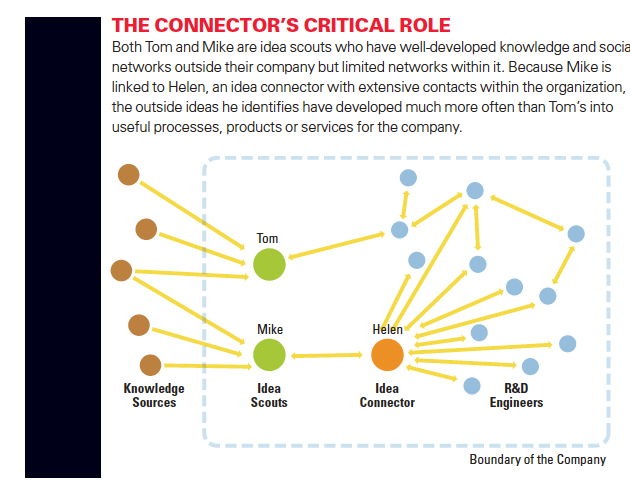

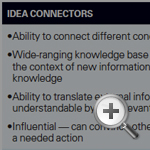
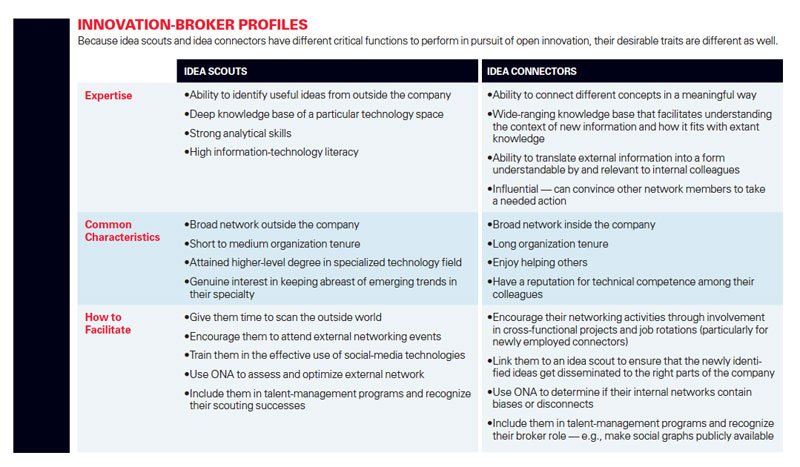
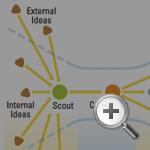
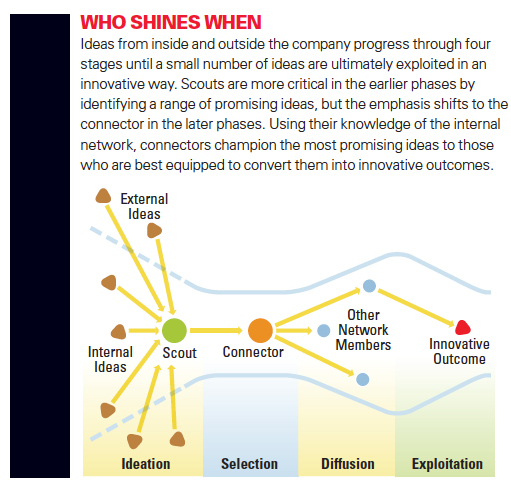
Comments (5)
Innovation Versus Efficiency - Bank Innovators Council
Innovation Versus Efficiency | Bank Innovation
Innovation Versus Efficiency - JPNicols.com
The Collaborative Advantage | Bank Innovators Council
Steven Weiss